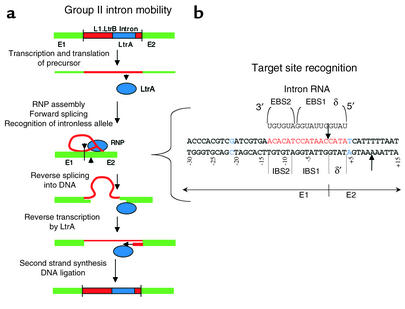Figure 3.
Group II intron mobility and revision of DNA. Mechanism of Group II L1.LtrB intron mobility. (a) A Group II intron (red) is found in the ltrB gene (green) of Lactococcus lactis between exons E1 and E2. The intron encodes the LtrA gene product (blue). Following transcription of the ltrB gene, the LtrA protein is translated from the intron-containing precursor. The LtrA protein facilitates self-splicing of the L1.LtrB intron. The excised intron is in the form of a lariat that is bound to the LtrA protein in an RNP particle. The assembled RNP targets an intronless allele for insertion into the DNA. The RNA component reverse-splices into the sense strand at the junction between E1 and E2. The LtrA protein then cleaves the antisense strand downstream of the intron insertion site, providing a template for reverse transcription by the LtrA protein. Second-strand synthesis and DNA repair complete the intron’s mobilization into the target DNA. (b) Target-site recognition by the retrohoming RNP is shown in greater detail. The EBSs of the intron (EBS1, EBS2, and δ) pair with IBSs IBS1, IBS2, and δ′ in the target (shown in red). Two bp’s, at –21 and +5 (shown in blue), strongly influence the activity of the LtrA protein during retrohoming (6). Cleavage sites are shown by the arrows. The top (sense) strand is cleaved by the RNA. LtrA cleaves the bottom strand following reverse splicing of the intron.

